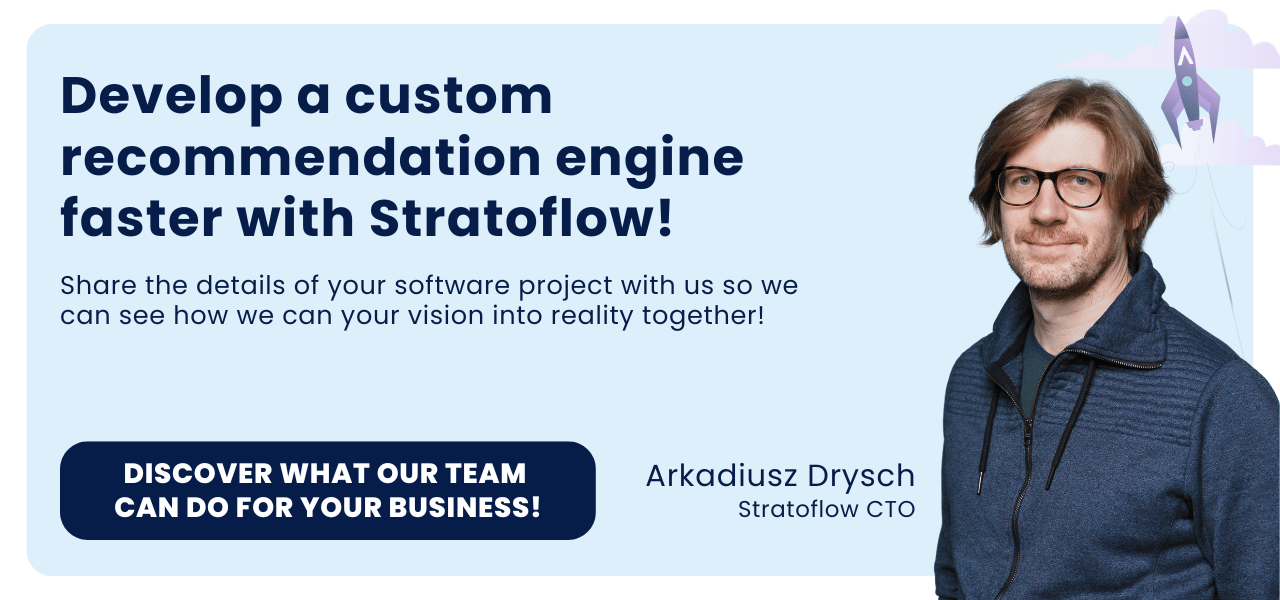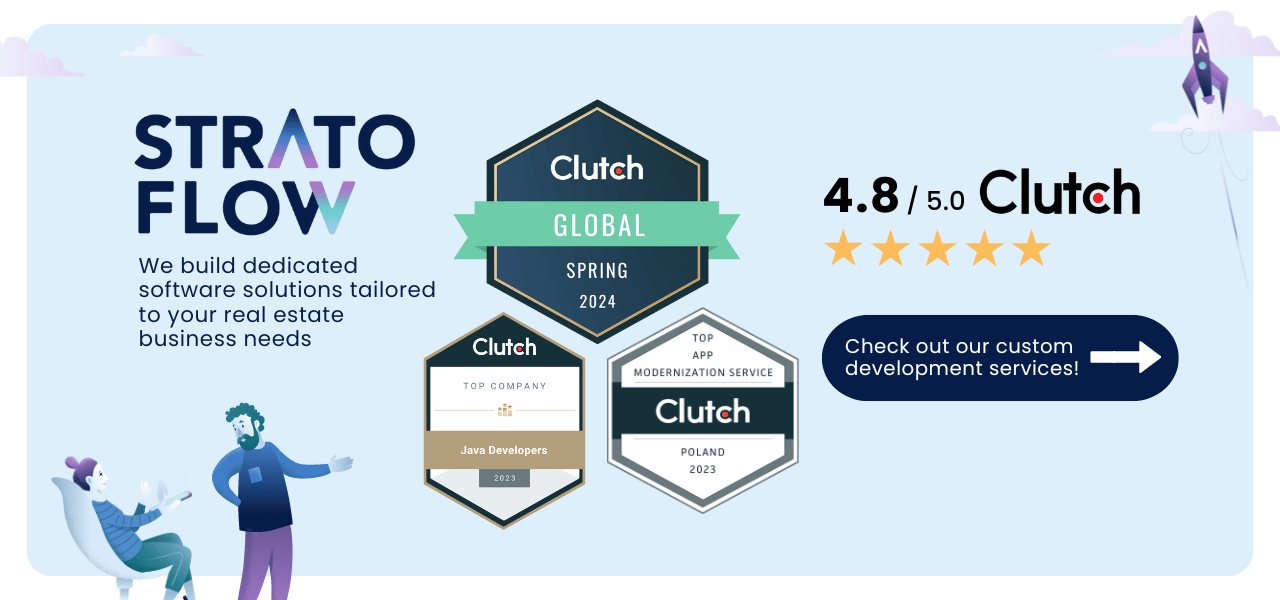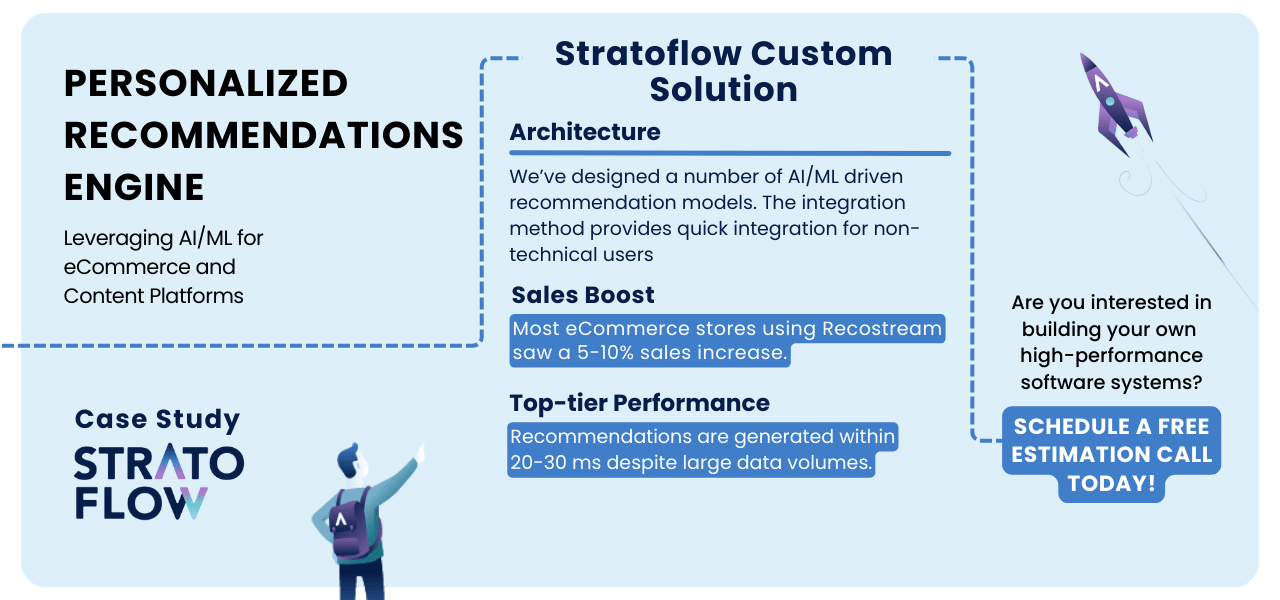
Types of Recommendation System For Business Growth: Your Guide
Ever wonder how websites and apps seem to know exactly what you’d like to watch, read, or buy next? It’s all thanks to recommendation engines, also known as “recs,” “recommender systems,” or “suggestive algorithms.” These systems help you discover new movies on streaming platforms, exciting games, your next YouTube binge, or even that perfect pair of sneakers on your favorite online store. They’re the reason why, after watching one cute kitten video, you find yourself in a never-ending loop of adorable animal clips.
So if you want to find out how these algorithms actually work, you’ve come to the right place to learn. We’ve built powerful recommendation systems, and now our mission is to share our expertise in a way that’s easy to understand to anyone.
Contents
- What is a recommendation system?
- How does a recommendation system work?
- Machine learning techniques in recommendation systems
- Types of recommendation systems
- How to build a recommendation engine?
- Benefits of recommendation systems
- How to choose the right recommendation engine
- What industries use recommendation systems?
- Real-world use cases and examples of recommendation systems
Key takeaways
- A recommendation engine is an AI-driven system that generates personalized suggestions to users based on collected data.
- The recommendation process consists of 4 main steps: collecting, analyzing, and filtering data, and then generating recommendations using machine learning techniques.
- There are 4 main types of recommender systems that use different filtering methods: content-based filtering, collaborative filtering, hybrid method, and deep learning-based.
- There are many business benefits of using recommender systems: personalized UX, increased revenue, enhanced user engagement, among others.
- Various industries utilize recommendation systems: ecommerce, media, entertainment, travel, gaming, and more.
- To choose the right recommender system, consider either out-of-the-box tools or scalable custom solutions.
What is a recommendation system?
A recommendation engine is an advanced technology that utilizes machine learning and data analysis to provide personalized suggestions to users. It operates by collecting and analyzing user behavior, user preferences, and historical user item interactions.
By applying complex algorithms and statistical models, recommendation engines are capable of predicting and presenting users with items, services, or content that align with their interests and preferences.
There are different types of recommendation systems, including collaborative filtering methods, content-based filtering, and user-based collaborative filtering, and we’ll look at each of them in this article.
Recommender system technology is widely used across various industries, particularly in e-commerce, streaming platforms, news and media, and digital marketing, to enhance user engagement, boost user trust, increase sales, and improve overall customer satisfaction. A based recommender system can make suggestions based on specific criteria such as user needs and preferences, object features, utility computation, and demographic attributes.
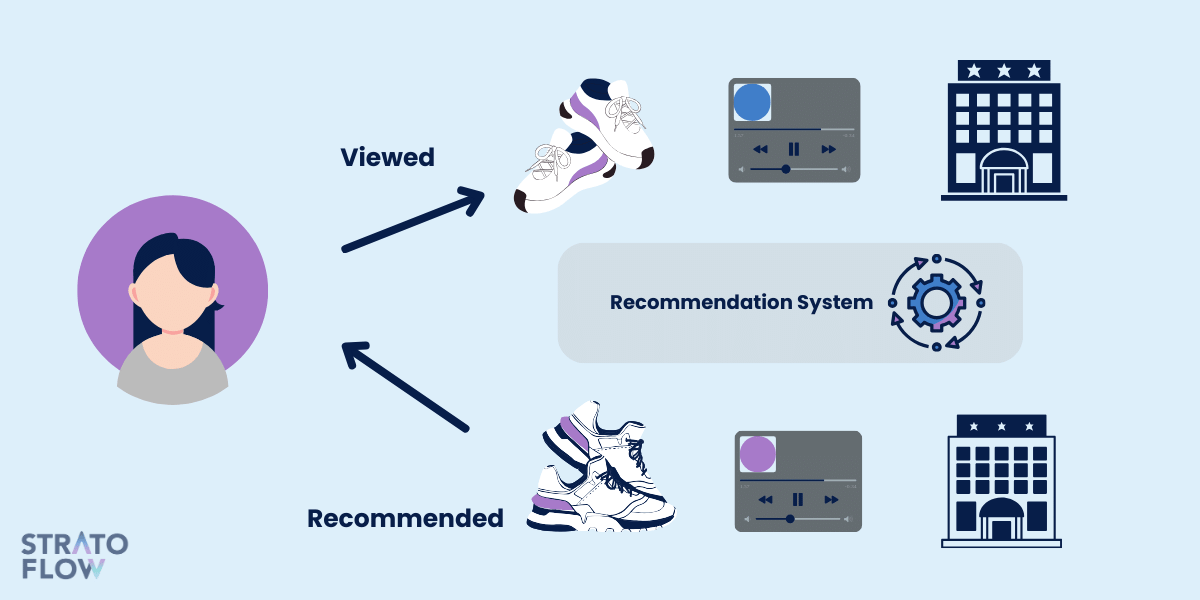
How does a recommendation system work?
We are often asked by our clients how exactly the recommendation engine works.
To explain in simple, non-technical terms, we always describe the process in the following four main steps:
Step 1: Collecting user data
Recommendation systems primarily collect data through user interactions, including clicks, views, and purchase history of different users.
Additionally, user feedback such as user ratings and reviews are also collected, as well as user profiles which incorporate demographics and browsing patterns, and item attributes, including product descriptions and tags.
Insights are also gained through the user’s past behavior. External sources like social media, third-party reviews, and real-time session data are integral to expanding the system’s knowledge base. They provide crucial insights that allow us to better understand our customers and improve our business practices.
Gathering data is the most critical phase of the recommendation process.
In case of insufficient data, especially at the very beginning, the cold start problem can occur. The cold start issue in recommendation engines happens when there isn’t enough data to make predictions for a new user. Absent previous user interaction, the system has difficulty in proposing customized recommendations for new users and items. This obstacle might affect user engagement and the effectiveness of the recommendation system.
Step 2: Analyzing data
By analyzing mentioned data, recommendation systems can effectively predict and meet the user’s preferences.
Most recommender systems analyze a combination of factors to predict a user’s preference and display the most accurate recommendation.
Recommendation system monitors website traffic to identify popular content and examine the content’s elements to match them with user interactions. User feedback shapes the recommendations, and the systems take into account patterns from user sessions and the preferences of similar users. Attributes like the brand or color of the item can also help to further refine the recommendations.
Depending on the recommendation engine, there can be additional factors that affect the suggestions. These additional factors make sure that every user receives a personalized experience.
Step 3: Filtering
In this phase, data is subjected to an advanced process utilizing a matrix factorization method.
Depending on whether it’s a collaborative, content-based, or hybrid recommendation model (you will learn more about these methods in the following part of this article), specific matrices and mathematical algorithms are applied.
The end product of this advanced matrix computation is the final set of recommendations.
Step 4: Generating recommendations
In this stage, known as ‘candidate generation‘, the recommendation system creates a selection of potential options based on the user’s input.
A recommender system then improve this selection by prioritizing the most suitable options. The efficiency of this ranking is key to delivering successful recommendations.
The use of artificial intelligence (AI) is essential to this process. The best recommendation platforms use adaptive AI models that continuously capture and process user preferences, similar to a market analyst understanding customer trends.
Thanks to advanced machine learning techniques, recommendations can be tailored to each user’s individual needs.
Machine learning techniques in recommendation systems
So, what mechanism drives the data analysis that generates the final recommendation? Surprise, surprise: it’s AI.
Machine learning, as a subcategory of artificial intelligence, enables recommender systems to recognize patterns and relationships in large historical datasets, such as understanding complex aspects of user’s behavior.
For generating tailored content, recommendation systems rely on specific training data and algorithms.
While deep learning models with neural networks are complex, traditional machine learning models enable systems to adapt and learn without direct programming.
It’s worth noting that recommendation system learning doesn’t necessarily depend on deep neural networks or advanced deep learning techniques, such as natural language processing.
They can still deliver precise product recommendations for users without these advanced methods.
Data security
Machine learning begins by collecting data in a database. Next, the system analyzes the data, whether it is focused on content or user behavior. After that, the data is categorized, learned from, and used to derive precise insights and forecasts.
So, how do we identify visitors?
The simple answer is cookies. These small text files contain a unique string of characters that are essential for identifying users. Often, product recommendations depend on the system’s ability to track user behavior. However, attributing this data to a specific individual requires the use of cookies, which are essential.
Although there is a general concern for personal data protection, cookies do not store details such as names, credit card information, or other personal identifiers. They only contain a code that identifies a particular visitor.
Using a cookie-driven recommendation engine, systems can link users to their respective sessions, allowing for the reconstruction of user pathways. It should be noted that not all visitors may agree to the cookie policy.
4 types of recommendation systems
As mentioned earlier, there are four main recommendation filtering methods that are most commonly used.
Thanks to the application of different methods, the suggestions are varied and as accurate as possible. It is worth blending them to achieve optimal results.
1. Collaborative filtering recommender systems
Collaborative filtering method is one of the most common techniques used in recommender systems. It operates on the principle of user-item interactions.
The main idea is that if two users agree on the evaluation of certain items, they will likely agree on the evaluation of other items as well.
Collaborative filtering can be further divided into two types:
User-based Collaborative Filtering
The user-based collaborative filtering method finds similar users to the target user and recommends items that those similar users have liked. For instance, if Alice and Bob both liked movies X and Y, and Bob also liked movie Z, then the system might recommend movie Z to Alice.
Item-based Collaborative Filtering
Instead of finding user similarities, this method focuses on item similarities. If users A and B both liked item 1 and item 2, then the items are considered similar. Hence, if user A likes item 3, it might be recommended to user B.
2. Content based recommender systems
Content-based recommender systems focus on the attributes of items and give you recommendations based on the similarity between them.
For instance, in case of movie recommendation system, if a user has shown interest in a particular type of movie, the system will recommend movies that fall into that category.
The content of each item is represented as a set of descriptors or terms that are inherent to the item.
For example, in a content-based movie recommendation system, the features of the movie, such as genre, director, actor, etc., can be used to describe the movie and recommend similar items.
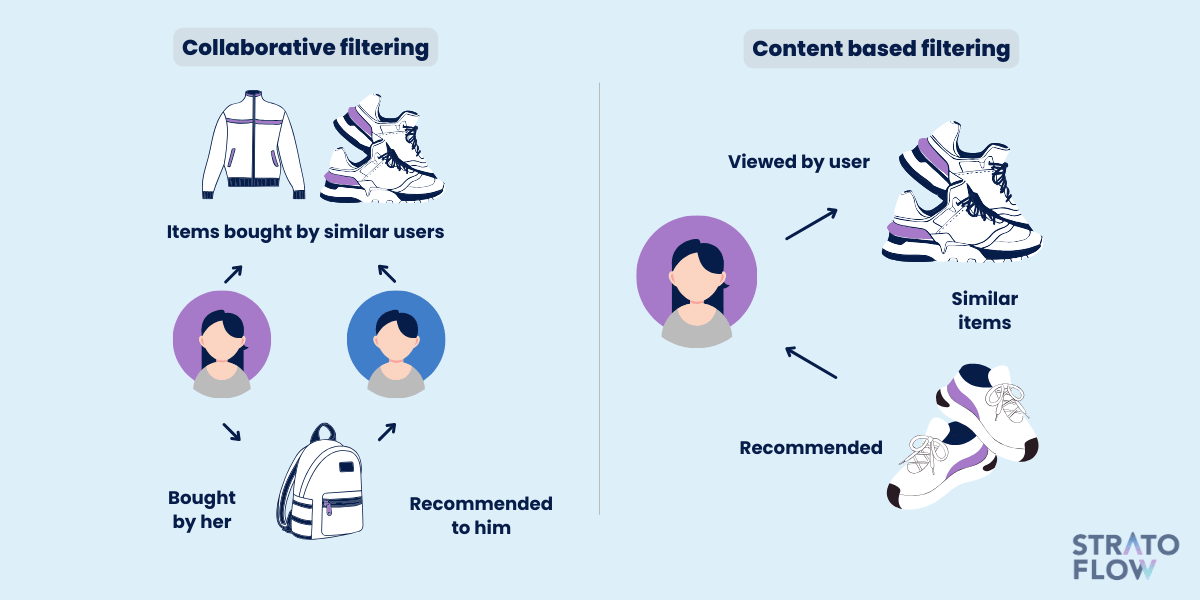
3. Hybrid recommender systems
Hybrid recommendation systems combine both collaborative filtering approach and content-based filtering to provide recommendations.
Hybrid systems can be implemented in several ways:
- By making predictions separately with each approach and combining them.
- By adding collaborative filtering and content-based filtering capabilities together.
- By unifying the approaches into a single model.
The main advantage of hybrid systems is that they can address the limitations of both collaborative filtering and content-based filtering systems.
For example, they can provide personalized recommendations to users with unique tastes and can handle situations where there’s limited user-item interaction data. This avoids the previously mentioned cold start problem.
4. Deep learning-based recommendations
Deep learning-based recommendation systems utilize deep neural networks to make predictions or recommendations.
These systems can automatically learn and extract features from raw data, making them highly effective, especially with large datasets.
Deep learning models, such as Convolutional Neural Networks (CNNs) for image data or Recurrent Neural Networks (RNNs) for sequential data, can be used depending on the type of data at hand.
For instance, platforms like YouTube use deep learning recommenders to suggest videos to users based on their viewing history. Additionally, a demographic based recommender system categorizes users based on attributes and makes recommendations without requiring a history of user ratings.
How To Build a Recommendation Engine: Real Life Case Study
So, we know how these systems work and how to choose one.
Now, let’s see how we can build one.
We’re a team that builds custom software on daily basis, and we’ve built recommendation engines from scratch for various sectors from ecommerce to media and marketing.
Do get more in-depth outlook on the whole process we heiglhy recommend checking out our complete guide to recommendation engines: How to Build a Recommendation System: Explained Step by Step.
So in the nutshell the entire process of building a custom recommendation engine can be divided into seven key steps:
- Gather Data: Begin by analyzing the data that an application collects, possesses, or has the potential to obtain.
- Identify Useful Data: Determine which pieces of data will be beneficial for generating recommendations.
- Design the Database: Plan and design a database model tailored to collect and store the identified data.
- Integrate Systems: Establish a connection between the recommendation engine and the application to enable smooth data transfer.
- Develop the Mechanism: Work on creating a mechanism that will generate recommendations. This will be based on the algorithm configuration you choose, which is a crucial component of the engine.
- Algorithm Creation: Dive into the development and fine-tuning of the algorithms that will power the recommendation engine.
- Finalize Integration: Ensure a seamless integration between the application and the recommendation engine, allowing for easy retrieval of recommendations.
Following the seven key steps of building a custom recommendation engine – from gathering data and designing recommendation models to development, and deployment – is crucial for delivering a quality product because each phase addresses a critical aspect of the system’s functionality and effectiveness.
Agile methodology plays a vital role in this process by enabling iterative development, continuous feedback, and quick adaptations to changing requirements, ensuring that the final product is both efficient and responsive to user needs.
Having said that developing a custom recommendation engine is by far not an easy feat.
It requires a lot of previous knowledge and experience to tailor the product to the unique data of your business.
That’s why employing professionals experienced in developing such systems is so important, as their expertise helps navigate the complexities of each step, ensuring a smooth, efficient development process and a high-quality end product, experts like Stratoflow.
At Stratoflow, we specialize in developing personalized AI-enabled recommendation engines tailored to various industries, enhancing user engagement and business efficiency.
Our expertise spans industries such as:
- E-commerce and Retail: Tailor product recommendations to increase sales, customer satisfaction, and engagement by analyzing browsing and purchase behavior.
- Media and Entertainment: Suggest movies, shows, music, or articles to enhance user experience and retention on streaming services and news platforms.
- Education: Develop customized learning paths for online students, recommending courses, resources, and activities based on individual progress and interests.
- Healthcare: Create personalized treatment plans and diagnostic recommendations to improve patient outcomes by analyzing medical history and lifestyle data.
- Insurance: Provide personalized financial advice, risk assessments, and policy recommendations by analyzing personal data and behavior.
- Finance: Offer tailored investment advice and financial planning based on individual financial profiles and goals.
- Real Estate: Tailor property recommendations and market analysis to individual preferences, improving the home buying or renting experience.
- Customer Service: Implement AI chatbots and virtual assistants to provide personalized support and solutions based on customer interactions and history.
- Travel: Develop personalized itineraries, recommend travel destinations, and offer dynamic pricing deals to enhance the travel planning experience and customer satisfaction.
By leveraging advanced machine learning algorithms, we deliver highly relevant product, content, and service recommendations that boost sales, customer loyalty, and satisfaction.
Our expertise in developing AI-enabled recommendation engines is best demonstrated through our work on Recostream.
Our solution incorporated advanced AI and machine learning models, offering quick and seamless integration with minimal client-side technical resources.
By leveraging Google Analytics and Google Optimize, we enabled clients to track and validate the engine’s performance effectively.
The result was a significant boost in sales, enhanced customer engagement, and a system capable of delivering recommendations with lightning-fast response times of 20-30 milliseconds.
This success culminated in Recostream’s acquisition by GetResponse, underscoring the robustness and efficacy of our solution.
Ready to elevate your business with personalized, AI-driven solutions?
Partner with us to build cutting-edge recommendation engines tailored to your unique needs.
Our proven expertise ensures seamless integration, enhanced customer engagement, and up to 10% boosts in sales!
Empower Your Business With AI-Driven Recommendation Engine!
Benefits of recommendation systems
Recommendation systems are now an essential component of various digital platforms, ranging from e-commerce websites to streaming services.
Each platform benefits differently from the recommender system. We all can observe the effects of the recommendation system on a daily basis. Recommender systems lead to a better user experience and significantly reduce the time spent searching for the best items.
So now, let’s see what are the benefits of recommender systems from a business perspective.
Personalized user experience
One of the primary advantages of a recommendation system is the ability to provide a personalized experience for each user. By analyzing user behavior and preferences, these systems can suggest products, content, or services that align with individual tastes.
Increased sales and revenue
By suggesting relevant and personalized products or content, recommender systems can drive more sales. This not only boosts the conversion rate but also increases the overall revenue for businesses.
Enhanced user engagement
When users are presented with content or products that resonate with their preferences, they are more likely to engage. This can lead to longer session times and more frequent visits.
Efficient discovery of new content
With the vast amount of content available online, discovering something new can be a challenge. Recommender systems help in this by introducing users to new products or content that they might not have stumbled upon otherwise.
Improved decision making for businesses
Understanding what users are looking for can inform decisions related to inventory management, marketing strategies, and more.
Enhanced customer satisfaction
Meeting and exceeding user expectations can lead to higher satisfaction levels. When users consistently find what they’re looking for, their overall satisfaction with the platform increases.
Targeted advertising
For platforms that rely on advertising revenue, recommendation systems can be invaluable. By understanding user preferences, businesses can serve more relevant ads, leading to higher click-through rates.
How to choose the right recommendation engine: most important criteria
1. Solution type: Out-of-the-box vs. Custom
Decide between an “out-of-the-box” recommendation system and a custom-built solution. Out-of-the-box solutions are ready-made and can be quickly integrated into your system. On the other hand, custom recommender systems are tailored to your specific business needs, offering more flexibility and customization.
For various businesses in industries like travel, fintech, insurance, real estate or media custom approach is the only way to achieve desired results in terms of sales and conversion rates.
Check out how we can tailor personalization engines to your Business!
2. Understand the pricing model
If you’re leaning towards an out-of-the-box recommender system, it’s crucial to understand its pricing structure. Some providers charge based on the number of users, while others base their fees on the number of recommendations made. It’s essential to choose a model that aligns with your business’s financial strategy.
3. Choosing the right tech partner
For those considering a custom recommender system, choosing the right technology partner is paramount. You should:
- Evaluate their expertise to ensure they have the technical know-how.
- Consider their experience and how long they’ve been in the industry.
- Review their portfolio to see if they’ve built systems similar to what you’re envisioning.
- Check their performance metrics to gauge how successful, powerful, and scalable their systems have been in the past.
4. Prioritize scalability
Your chosen recommendation system should be scalable. As your website traffic grows, the system should adapt without compromising its performance. This ensures that as your business expands, your recommendation engine remains efficient and effective.
5. Addressing the cold start problem
Especially for smaller stores, the cold start problem can be a challenge. This issue arises when there’s insufficient data to make accurate recommendations. It’s vital to select a system capable of providing precise suggestions even if you’re operating a smaller shop.
6. Collaboration and alignment
Ensure that you partner with a provider whose values and vision align with yours. A shared approach and working style can lead to smoother collaboration and more successful integration of the recommender system into your business operations.
7. Integration and compatibility
The recommendation engine should easily integrate with your existing systems, platforms, and software. Check for compatibility with your current tech stack to avoid potential integration challenges and additional costs.
8. Real-time recommendations
Opt for a solution that offers real-time recommendations. As user behavior and preferences change, the system should instantly update its suggestions, ensuring that users always receive the most relevant and timely product or content recommendations.
9. Flexibility and customizability
The business landscape is ever-evolving. Choose a recommendation engine that offers flexibility in terms of features and customizability. This ensures that as your business needs change, your recommendation system can adapt accordingly.
10. Cost of maintenance and support
Beyond the initial investment, consider the ongoing costs of maintaining the system. Additionally, ensure that the provider offers reliable customer support to address any issues or challenges that may arise.
What industries use recommendation systems?
E-commerce
In the e-commerce industry, recommender systems play a crucial role in enhancing user experience and driving sales. They analyze a user’s browsing and purchase history to suggest products that are likely to interest them. These recommendations often appear in the “You Might Also Like” or “Customers Who Bought This Also Bought” sections. By personalizing the shopping journey, e-commerce platforms increase customer engagement and boost revenue.
Entertainment and streaming services
Streaming platforms like Netflix, Spotify, and YouTube leverage recommender systems to keep users engaged and entertained. These systems use algorithms to analyze a user’s viewing or listening history and recommend movies, music, or videos that align with their preferences. This keeps users on the platform longer and increases content consumption.

Social media platforms
Social media platforms such as Facebook, Instagram, and Twitter employ recommendation engines to suggest friends to connect with, posts to interact with, and groups to join. These systems analyze user interactions and interests to create personalized feeds, increasing user engagement and time spent on the platform.
Gaming industry
In the gaming industry, recommendation systems help players discover new games, in-game items, and opponents. They analyze player behavior and preferences to suggest games that align with a player’s interests or to match players with similar skill levels. This enhances the gaming experience and encourages players to explore more titles.
News and media
News websites and media platforms use recommender systems to deliver personalized news articles, videos, and advertisements. By analyzing user reading habits and content preferences, these systems ensure that users are presented with relevant and engaging content, ultimately increasing user retention and ad revenue.
Travel and hospitality
In the travel industry, recommendation engines assist users in finding suitable hotels, flights, and travel itineraries (e.i. travel meta search engines, booking engines, hotel booking engines). These systems consider a user’s past travel history, preferences, and budget to suggest tailored options, making travel planning more convenient and enjoyable.

Healthcare
Healthcare providers use recommendation systems to suggest treatment plans and medical services based on a patient’s medical history, symptoms, and demographics. This personalized approach improves patient care and outcomes.
Finance
In the financial sector, recommender systems suggest investment opportunities, financial products, and personalized banking services based on a user’s financial history and goals. The use of recommender systems in banking technology helps users make informed financial decisions and enhances the customer experience.
Education
In the field of education, recommender systems suggest courses, learning materials, and study paths based on a student’s educational history and learning preferences. These systems promote personalized learning experiences, improving educational outcomes.
Advertising and marketing
In the advertising and marketing industry, recommendation engines deliver targeted advertisements and marketing campaigns to users based on their behavior and interests. This increases the effectiveness of marketing efforts and boosts conversion rates.
Automotive
In the automotive sector, recommendation systems suggest vehicles, maintenance schedules, and related services based on a user’s vehicle history and preferences. This enhances the customer experience and encourages vehicle maintenance.
These are just a few examples of how recommender systems are utilized across various industries to improve user engagement, drive revenue, and provide personalized experiences.
Real-world use cases and examples of recommendation systems
Recommendation systems in ecommerce
Amazon’s recommendation system
Amazon is renowned for its highly accurate product recommendations in its online store. The company leverages advanced technologies, including:
- Artificial intelligence algorithms: These algorithms analyze vast amounts of data to predict what products a user might be interested in.
- Machine learning: Amazon recommendation engine uses machine learning to continuously improve and refine its recommendation system based on user behavior and feedback.
- Collaborative filtering: Generates recommendations to other users based on the behavior of similar users.
- Personalized recommendations: Amazon’s system tailors product suggestions based on individual user behavior, browsing history, and purchase history.
- Item-to-Item collaborative filtering: Instead of segmenting users into groups, Amazon uses collaborative filtering method to match each product to a set of similar products. This way, when a particular user views a product, they get recommendations of similar items.

Shopify’s recommendation system:
Shopify, a leading e-commerce platform, also employs recommendation systems to enhance the shopping experience for its merchants and their customers.
- Collaborative filtering: Similar to Amazon, Shopify uses collaborative filtering techniques to generate user recommendations based on the behavior of similar users.
- Data-driven recommendations: Shopify’s recommendation system is heavily data-driven. It analyzes user behavior, user’s preferences, user satisfaction, purchase history, user interest, and other relevant data to provide accurate product suggestions.
- Personalized product recommendations: Shopify’s system offers personalized product suggestions tailored to individual user behavior, preferences, and user’s existing interests.
- Complementary Recommendations: Some themes on Shopify have sections that display complementary products to customers on product pages. These are products that go well with the main product being viewed.
- Related Recommendations: These are auto-generated by Shopify and show products that are related or similar to the main product being viewed.

Recommendation systems in streaming
Recommendation systems play a pivotal role in the success of streaming platforms like Netflix and Spotify. Here’s a brief overview of how these systems work for each platform:
Netflix recommender system
- User behavior tracking: Netflix tracks every action a user takes on their platform, from the movies and series they watch to the ratings they give and even the time they spend on particular scenes.
- Content tagging: Every piece of content on Netflix is tagged with metadata by both algorithms and human experts. This metadata can include information about the genre, actors, director, and even nuanced details like the mood of the content.
- Matrix factorization: Netflix movie recommendation engine employs matrix factorization techniques to decompose the user-item interaction matrix. This helps in predicting the rating a user would give to an unseen movie based on their past behavior.
- Deep learning: Netflix also uses deep learning models to predict user preferences. These models can capture complex non-linear patterns in the data which traditional algorithms might miss.
- Personalized thumbnails: Even the thumbnails users see for movies and series are personalized based on their past behavior. For instance, a user who frequently watches romantic movies might see a thumbnail highlighting the romantic aspect of a movie, even if it’s an action film.
- A/B testing: Netflix constantly tests its recommendation algorithms using A/B testing to ensure that users are getting the most relevant content suggestions.
Deliver Netflix-like recommendations to your customers!
Spotify recommender system
- User listening habits: Spotify tracks the songs, albums, and playlists users listen to. It also considers the frequency, recency, and duration of listening sessions.
- Collaborative filtering: This method predicts a user’s interests by collecting preferences from many users. If a person A has the same opinion as a person B on an issue, A is more likely to have B’s opinion on a different issue.
- Content-based filtering: Spotify analyzes the raw audio tracks of songs to identify features like tempo, instrumentation, and genre. This allows the platform to recommend songs that are sonically similar to what a user has been listening to.
- Matrix factorization: Like Netflix, Spotify also uses matrix factorization techniques to predict songs a user might like based on their past listening history.
- Natural Language Processing (NLP): Spotify scans the web for articles, blogs, and other textual content about songs and artists to understand public opinion and sentiment. This helps in making more informed recommendations.
- Playlist personalization: Playlists like “Discover Weekly” and “Release Radar” are personalized for each user based on their listening habits and the algorithms’ predictions.
Recommendation systems in marketing
GetResponse
- AI/ML-driven models: GetResponse has several AI/ML-driven recommendation models. These models are designed to provide highly accurate and personalized content suggestions to users.
- AI-Driven product recommendations: On the GetResponse platform, AI product recommendations use artificial intelligence to match product offerings to the preferences, needs, and habits of each store visitor. This ensures that users are presented with products and services that align with their interests and behaviors.
GetResponse uses a recommendation engine built by our team. The company has acquired Recostream, an AI/ML personalized recommendations technology product: read more about this project here. This acquisition aimed to add AI product recommendations to GetResponse’s personalization functionality, further enhancing the platform’s capabilities.
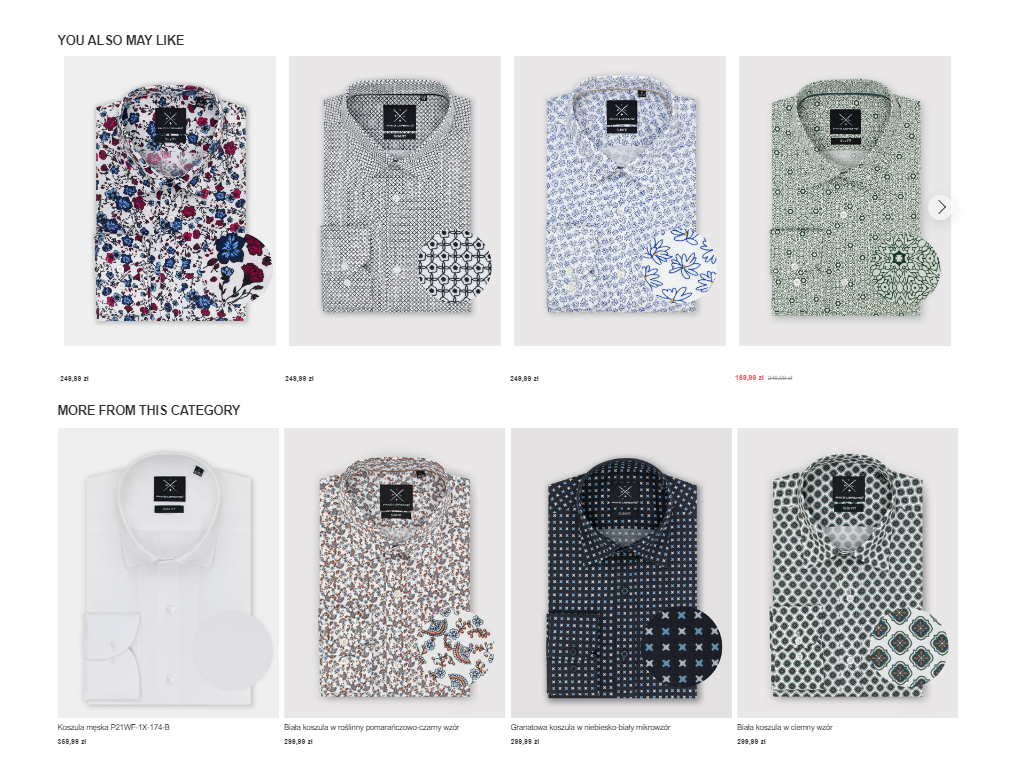
TikTok
TikTok collects a vast amount of data from its users. This data includes user interactions, video information, device information, and more. By analyzing this data, TikTok can understand user preferences and behaviors, allowing it to make more accurate content recommendations.
TikTok’s recommendation system stands out due to its high effectiveness in suggesting content that users find engaging and relevant. This effectiveness is a result of the platform’s advanced algorithms and its ability to analyze vast amounts of data in real-time.
Recommendation system – summary
Recommendation systems are AI-driven engines that provide tailored suggestions to users by analyzing collected data. The recommendation process undergoes four primary stages: data collection, analysis, filtering, and the application of machine learning techniques to produce recommendations. Among the four main types of recommender systems are content-based filtering and collaborative filtering based methods, which often utilize a user-item matrix. The latter, collaborative filtering, particularly focuses on recommendations derived from the preferences of other users. Additionally, hybrid methods and deep learning-based systems offer more advanced recommendation techniques.
Implementing a recommendation system offers businesses numerous advantages, including a personalized user experience (UX), heightened user engagement, and potential revenue growth. These systems are prevalent across various sectors, from ecommerce and entertainment to travel and gaming. When selecting an appropriate recommendation system, businesses can opt for ready-made tools or invest in scalable custom solutions.
Related Posts
- How to Boost Your Sales with a Product Recommender Tool
- Best AI for Coding: Top 10 AI Tools for Software Developers in 2025
- How to Build a Recommendation System: Explained Step by Step
- 11 Best Resources on Machine Learning Recommender Systems in 2025
- An In-Depth Guide to Machine Learning Recommendation Engines
Thank you for taking the time to read our blog post!
